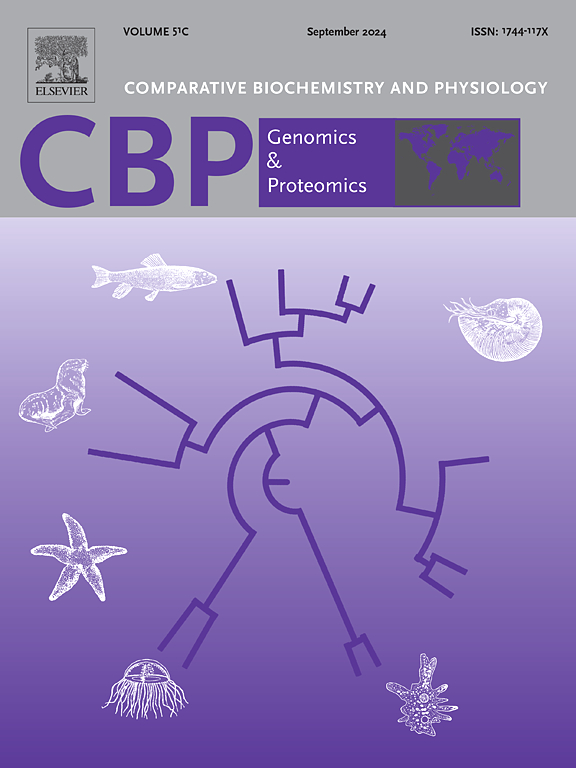Transcriptome analysis and machine learning methods reveal potential mechanisms of zebrafish muscle aging
IF 2.2
2区 生物学
Q4 BIOCHEMISTRY & MOLECULAR BIOLOGY
Comparative Biochemistry and Physiology D-Genomics & Proteomics
Pub Date : 2025-05-09
DOI:10.1016/j.cbd.2025.101532
引用次数: 0
Abstract
Muscle is one of the most abundant tissues in the human body, and its aging usually leads to many adverse consequences. Zebrafish is a powerful model used to study human muscle diseases, yet we know little about the molecular mechanisms of muscle aging in zebrafish. In this study, we determined the gene expression profiles of muscle tissues from male zebrafish of four different ages. Through differential expression analysis and expression pattern analysis, we identified a set of genes associated with muscle aging in zebrafish. Functional enrichment analysis revealed that several biological changes accompanied zebrafish muscle aging, including chronic inflammation, accumulation of sphingolipids, reduction of autophagy, and activation of the ferroptosis pathway. H&E staining showed that zebrafish muscle senescence leads to myofibrillar interstitial expansion and inflammatory cell infiltration. Furthermore, we screened zebrafish muscle aging related biomarkers by machine learning and verified the expression levels of some biomarkers by RT-qPCR. Based on these biomarkers, we constructed a zebrafish muscle aging clock that can predict muscle age based on transcriptomic data. This study provides us with a new perspective to understand the molecular mechanism of muscle aging and a new tool for zebrafish-based anti-aging research.

转录组分析和机器学习方法揭示了斑马鱼肌肉衰老的潜在机制
肌肉是人体最丰富的组织之一,它的老化通常会导致许多不良后果。斑马鱼是研究人类肌肉疾病的有力模型,但我们对斑马鱼肌肉衰老的分子机制知之甚少。在这项研究中,我们确定了四个不同年龄的雄性斑马鱼肌肉组织的基因表达谱。通过差异表达分析和表达模式分析,我们确定了一组与斑马鱼肌肉衰老相关的基因。功能富集分析显示,斑马鱼肌肉衰老过程中出现了多种生物学变化,包括慢性炎症、鞘脂积累、自噬减少和铁下垂途径激活。H&;E染色显示斑马鱼肌肉衰老导致肌纤维间质扩张和炎症细胞浸润。此外,我们通过机器学习筛选斑马鱼肌肉衰老相关的生物标志物,并通过RT-qPCR验证部分生物标志物的表达水平。基于这些生物标志物,我们构建了一个斑马鱼肌肉老化时钟,可以根据转录组学数据预测肌肉年龄。该研究为我们了解肌肉衰老的分子机制提供了新的视角,也为斑马鱼的抗衰老研究提供了新的工具。
本文章由计算机程序翻译,如有差异,请以英文原文为准。
求助全文
约1分钟内获得全文
求助全文
来源期刊
CiteScore
5.10
自引率
3.30%
发文量
69
审稿时长
33 days
期刊介绍:
Comparative Biochemistry & Physiology (CBP) publishes papers in comparative, environmental and evolutionary physiology.
Part D: Genomics and Proteomics (CBPD), focuses on “omics” approaches to physiology, including comparative and functional genomics, metagenomics, transcriptomics, proteomics, metabolomics, and lipidomics. Most studies employ “omics” and/or system biology to test specific hypotheses about molecular and biochemical mechanisms underlying physiological responses to the environment. We encourage papers that address fundamental questions in comparative physiology and biochemistry rather than studies with a focus that is purely technical, methodological or descriptive in nature.

 求助内容:
求助内容: 应助结果提醒方式:
应助结果提醒方式:


